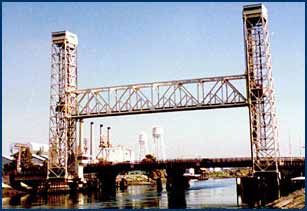Fruitvale Avenue Railroad Bridge

The Fruitvale Avenue Railroad Bridge is a vertical lift bridge for trains spanning the Oakland Estuary. The Oakland Estuary is a navigable water way with access to the San Francisco Bay and San Leandro Bays.
The Fruitvale Avenue Railroad bridge has two support towers for the counterweights, machinery rooms, and span. The towers are 185 feet tall with the machinery rooms at the top. Each Tower has a massive counterweight to help lift the bridge. While there are many different designs, all vertical lift bridges are based on this same engineering principle. Although it offers 13 feet of vertical clearance when closed, it is kept at 65' or mid-open and lowered when a train needs to pass over it.
HISTORY
The Fruitvale Avenue Railroad Bridge was completed in 1951 by the United States Army Corp of Engineers. It is owned by the United States Army Corp of Engineers and maintained and operated by the Alameda County Public Works Agency. The prime contractors were Ben C. Gerwick, Southern Pacific, Judson-Pacific, Murphy Construction, and Independent Construction Company. It cost $946,757 to build.
OPENING
The Fruitvale Avenue Railroad Bridge shall open on signal; except that, from 8:00 a.m. to 9:00 a.m. and 4:30 p.m. to 6:30 p.m. Monday through Friday except Federal Holidays, the draws need not be open for the passage of vessels. However, the draws shall open for the above closed periods for vessels which must, for reasons of safety, move on a tide or slack water, if at least two hours notice is given. The draws shall open as soon as possible for commercial vessels engaged in rescue or emergency salvage operations.
The bridge is manned by an alternating four person crew. The Bridge Tender on duty at Miller-Sweeney Bridge operates the Fruitvale Avenue Railroad Bridge. The bridge is maintained at a height of 65 feet above the water. If a vessel needs more clearance a request must be made to the Bridge Tender on duty. The bridge is equipped with a Marine Radio, the preferred working channel in the San Francisco Bay Area is Channel 9 and Channel 16 is used for hailing and distress. Vessels can also gain a bridge opening by using a horn. The signal is a long blast followed by a short blast. Signal flags and lights may also be used if Coast Guard approved methods are followed. For more information on drawbridge operations, see "California Drawbridge Regulations" by the Coast Guard.
Maintained at a height of 65 feet above the water, the bridge is considered passable by most vessel traffic. The bridge can be raised to a height of 135 feet to accommodate larger vessels. There are a handful of openings a year where the bridge is raised to it full height.
The bridge receives approximately 30 train crossings per month. No vehicles or pedestrians are allowed on the bridge.
WORKINGS OF THE BRIDGE
The bridge is powered by four 19 hp motors. There are two motors in each tower. One is the main operational motor, the other is the backup motor. Each motor runs at 700 rpm.
The Railroad Bridge is the only bridge in the County that uses a Direct Current (DC) motor control system. The other bridges are all Alternating Current (AC) designs. With the DC drive system, power to the bridge can be variably applied, which gives the operator more control over the bridge. One of the drawbacks of the DC system at Fruitvale Avenue is its more complex than the other AC Designs.
Fruitvale Avenue has a unique power supply arrangement. Each tower of the bridge draws normal operating power from their side of the bridge. The South Tower draws power from the Bureau of Electricity (City of Alameda). The North Tower draws power from PG&E (Pacific Gas & Electric). Both power supplies have to be present in order for the bridge to operate under normal power. This requires a complex synchronization system in order to keep the bridge traveling properly. Without the synchronization the bridge will go out of alignment and possibly jam. The operator must carefully watch the gauges to ensure the bridge is moving correctly.
The power supply is interconnected so if one side loses power you can switch operating power from one side to the other. When using only one power supply the bridge runs on the emergency drive system under reduced speeds.
The bridge is stopped by 8 brakes. There are 4 motor brakes with 400 lb./ft torque. The motor brakes are the main stopping brakes when the bridge is being raised or lowered. The other 4 brakes are called the machinery brakes. Once the bridge is stopped these brakes are set manually by the bridge tender. The machinery brakes have a stopping force of 1200lb/ft torque. The machinery brakes can stop the bridge in place for long periods of time.
During the Loma Prieta Earthquake in October 1989 the bridges main supporting bolts and gusset plates at the foundation were visibly stretched. Repairs to the mounting bolts and gusset plates were performed.
BRIDGE STATISTICS
- Vertical Clearance Down Position MHHW (High Tide) 13 Feet
- Vertical Clearance Up Position MHHW (High Tide) 135 Feet
- Clearance Between Fenders 200 Feet
- Tower Height 185 Feet
- Bridge Width 25 Feet 6 inches
- Span Length 200 Feet

